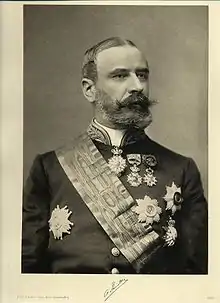1900 Belgian general election
Full general elections were held in Belgium on 27 May 1900.[1]
| |||||||||||||||||||||||||||||||||||||
All 152 seats in the Chamber of Representatives | |||||||||||||||||||||||||||||||||||||
|---|---|---|---|---|---|---|---|---|---|---|---|---|---|---|---|---|---|---|---|---|---|---|---|---|---|---|---|---|---|---|---|---|---|---|---|---|---|
| |||||||||||||||||||||||||||||||||||||
| |||||||||||||||||||||||||||||||||||||
 |
|---|
| This article is part of a series on the politics and government of Belgium |
|
|
They were the first elections under a proportional system (using the D'Hondt method) instead of a majority system. This was an innovation in Europe, as Belgium became the first country to adopt proportional representation as basis of its electoral system. To make the system possible, smaller electoral districts (arrondissements) were grouped into a single electoral district (a group of arrondissements). The introduction of proportional representation was beneficial to the Liberal Party, which significantly increased its number of seats. The Liberal Party previously suffered losses after the introduction of universal suffrage in 1894.
The Catholic Party thus lost seats but retained its absolute majority, with 86 of the 152 seats in the Chamber of Representatives and 44 of the 76 seats in the Senate.[2]
Results
Chamber of Representatives
| Party | Votes | % | Seats | +/– |
|---|---|---|---|---|
| Catholic Party | 993,945 | 48.46 | 86 | –22 |
| Liberal Party | 464,959 | 22.67 | 31 | +18 |
| Belgian Labour Party | 461,295 | 22.49 | 32 | +17 |
| Christian Democratic Party | 52,093 | 2.54 | 1 | 0 |
| Radical Party | 33,840 | 1.65 | 2 | New |
| Other parties | 44,782 | 2.18 | 0 | -2 |
| Liberal-Social Kartels | - | - | 0 | -8 |
| Gauche Left Kartels | - | - | 0 | -1 |
| Invalid/blank votes | 0 | – | – | – |
| Total | 2,050,914 | 100 | 152 | 0 |
| Source: Belgian Elections | ||||
Senate
| Party | Votes | % | Seats |
|---|---|---|---|
| Catholic Party | 911,262 | 52.8 | 44 |
| Liberal Party | 565,767 | 32.8 | 23 |
| Belgian Labour Party | 119,000 | 6.9 | 4 |
| Other parties | 129,636 | 7.5 | 5 |
| Invalid/blank votes | – | – | |
| Total | 1,725,665 | 100 | 76 |
| Source: Nohlen & Stöver | |||
Constituencies
The distribution of seats among the electoral districts was as follows for the Chamber of Representatives.[3] As the electoral system changed to a proportional one, the electoral arrondissements with only one or two representatives were grouped together to form larger ones. Each electoral district now had at least 3 representatives, with the exception of Neufchâteau-Virton.
| Province | Arrondissement | Previous | New |
|---|---|---|---|
| Antwerp | Antwerp | 11 | |
| Mechelen | 4 | ||
| Turnhout | 3 | ||
| Limburg | Hasselt | 3 | |
| Maaseik | 1 | 3 | |
| Tongeren | 2 | ||
| East Flanders | Aalst | 4 | |
| Oudenaarde | 3 | ||
| Gent | 9 | 10 | |
| Eeklo | 1 | ||
| Dendermonde | 3 | ||
| Sint-Niklaas | 4 | ||
| West Flanders | Bruges | 3 | |
| Roeselare | 2 | 4 | |
| Tielt | 2 | ||
| Kortrijk | 4 | ||
| Ypres | 3 | ||
| Veurne | 1 | 4 | |
| Diksmuide | 1 | ||
| Ostend | 2 | ||
| Brabant | Leuven | 6 | |
| Brussels | 18 | ||
| Nivelles | 4 | ||
| Hainaut | Tournai | 4 | 6 |
| Ath | 2 | ||
| Charleroi | 8 | ||
| Thuin | 3 | ||
| Mons | 6 | ||
| Soignies | 3 | ||
| Liège | Huy | 2 | 4 |
| Waremme | 2 | ||
| Liège | 11 | ||
| Verviers | 4 | ||
| Luxembourg | Arlon | 1 | 3 |
| Marche | 1 | ||
| Bastogne | 1 | ||
| Neufchâteau | 1 | 2 | |
| Virton | 1 | ||
| Namur | Namur | 4 | |
| Dinant | 2 | 4 | |
| Philippeville | 2 | ||
| 152 | 152 | ||
References
- Nohlen, Dieter; Stöver, Philip (31 May 2010). Elections in Europe: A data handbook. Nomos Verlagsgesellschaft. p. 289. ISBN 978-3-8329-5609-7.
- Nohlen & Stöver, pp307-310
- List of members of the Chamber of Representatives (1900-1901)


